Course Overview
In this course, students connect physical, verbal, and symbolic representations of the real number system; investigate properties including closure; demonstrate fluency in computations with real numbers; solve and graph linear equations and inequalities. Students use formulas to solve problems including exponential growth and decay; add, subtract, multiply, and divide monomials and polynomials; and solve quadratic equations with real roots by graphing, formula, and factoring. Students define functions, determine slope, calculate distance, and draw graphs of linear equations using slope, y-intercept, parallel, and perpendicular lines; determine the characteristics of linear, quadratic, and exponential functions; solve systems of linear equations involving two variables graphically and symbolically; simplify and compute with rational and radical expressions; model and solve problem situations involving direct and indirect variation.
In Algebra I, you will begin your journey to learn mathematical and theoretical concepts which lay the foundation to take more advanced math classes, both in high school and beyond. Mathematics knowledge is built in steps and Algebra I is one of its building blocks. With mastery of Algebra I skills, you will have a solid foundation to pursue many different paths and further your knowledge of mathematics.
EXPRESSIONS, VARIABLES, AND PROPERTIES
 |
Unit Overview
This unit will lay the foundation for the studies of Algebra. In this unit, you will be introduced to algebraic terminology, sets of numbers, and most importantly, identify the properties of addition and multiplication, which are extensively used in solving algebraic equations.
Sets of Numbers
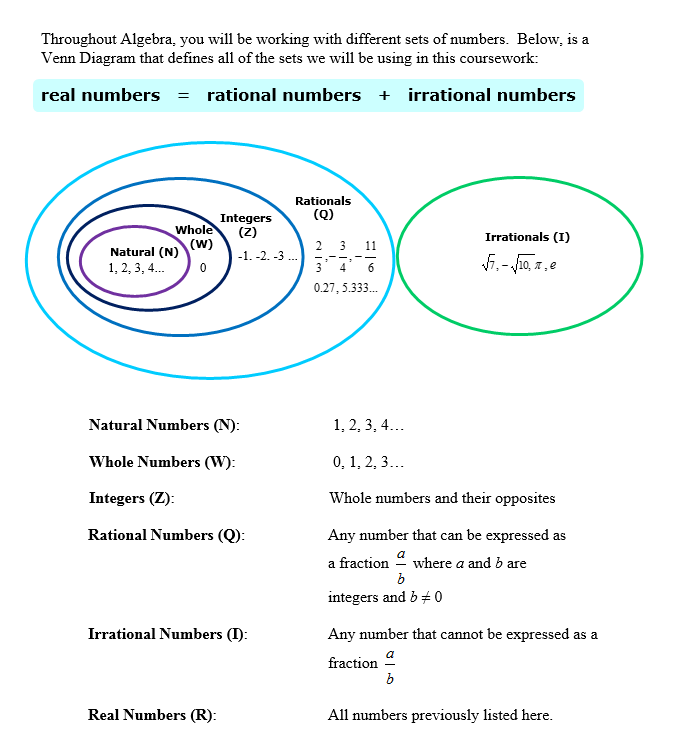 |
Stop! Go to Questions #1-4 about this section, then return to continue on to the next section.
Order of Operations
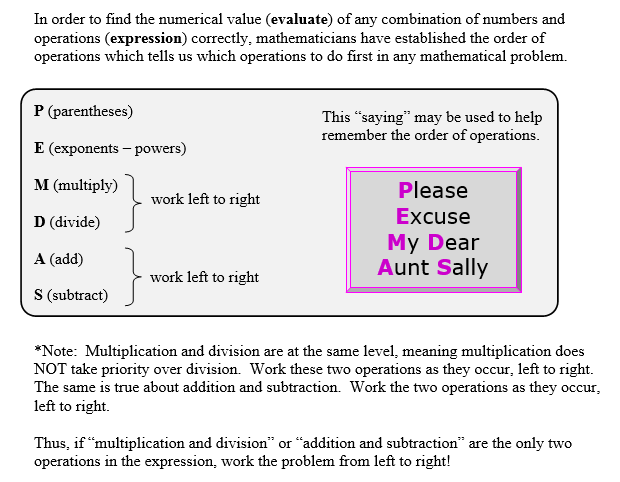 |
 |
Practice:
![]() To evaluate the expression 6[9 + 2(15 – 8)], what is the first step?
To evaluate the expression 6[9 + 2(15 – 8)], what is the first step?
6[9 + 2(7)] Parentheses first.
"Click here" to check the answer.
![]() What will the next step be?
What will the next step be?
6(9 +14) Multiply before adding.
"Click here" to check the answer.
![]() What will the next step be?
What will the next step be?
6(23) Parentheses first.
"Click here" to check the answer.
![]() What is the final answer?
What is the final answer?
138
"Click here" to check the answer.
You will continue to use the order of operations throughout the remainder of this unit and throughout any other mathematics courses you continue to take.
Stop! Go to Questions #5-9 about this section, then return to continue on to the next section.
Introduction to Variables and Expressions
 |
Practice:
![]() What must be done first to evaluate the following expression?
What must be done first to evaluate the following expression?
![]()
Substitute 2 in for "a", 3 in for "b", and 8 in for "c".
"Click here" to check the answer.
![]() What is the next step in calculating
What is the next step in calculating ![]() ?
?
Multiply.
"Click here" to check the answer.
![]() What is the next step in calculating
What is the next step in calculating ![]() ?
?
Multiply in the numerator of the fraction.
"Click here" to check the answer.
![]() What is the next step in calculating
What is the next step in calculating ![]() ?
?
Simplify the numerator and denominator of the fraction.
"Click here" to check the answer.
![]() What is the next step in calculating
What is the next step in calculating ![]() ?
?
Divide before subtracting.
"Click here" to check the answer.
![]() What is the final answer for 36 – 2?
What is the final answer for 36 – 2?
34
"Click here" to check the answer.
As you become more familiar with evaluating expressions, you will be able to perform more than one operation per step. For example, in the example above it would have been okay in step 2 to also multiply 2 and 3. Again you will be able to do this after more practice.
Stop! Go to Questions #10-14 about this section, then return to continue on to the next section.
Parts of an Algebraic Expression
 |
![]() What is the third term?
What is the third term?
13
"Click here" to check the answer.
|
![]() Which terms of the expression 5x + 6xz + 13 are variable terms?
Which terms of the expression 5x + 6xz + 13 are variable terms?
5x and 6xz
"Click here" to check the answer.
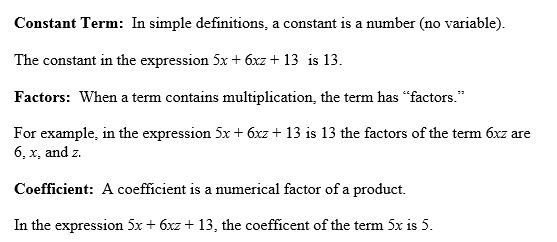 |
![]() Name another coefficient in the expression 5x + 6xz + 13.
Name another coefficient in the expression 5x + 6xz + 13.
6
"Click here" to check the answer.
 |
Stop! Go to Questions #15-20 about this section, then return to continue on to the next section.
Properties of Real Numbers
In the previous section, you learned how to translate verbal phrases into algebraic sentences. You were able to do this because of mathematical properties. In this section, you will study these properties that you will use in future units to solve equations.
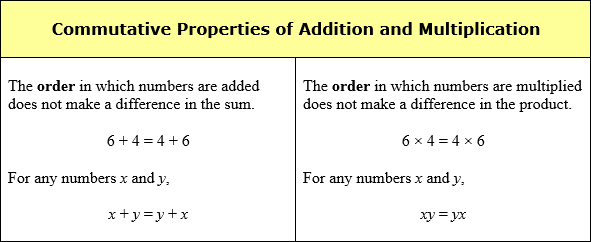 |
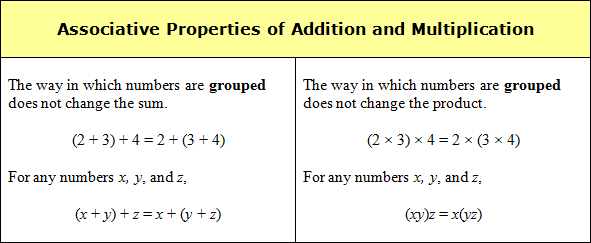 |
 |
 |
| Operation: An operation is a process such as addition, subtraction, multiplication, division, or square root that is performed in a specified sequence and in accordance with specific rules. |
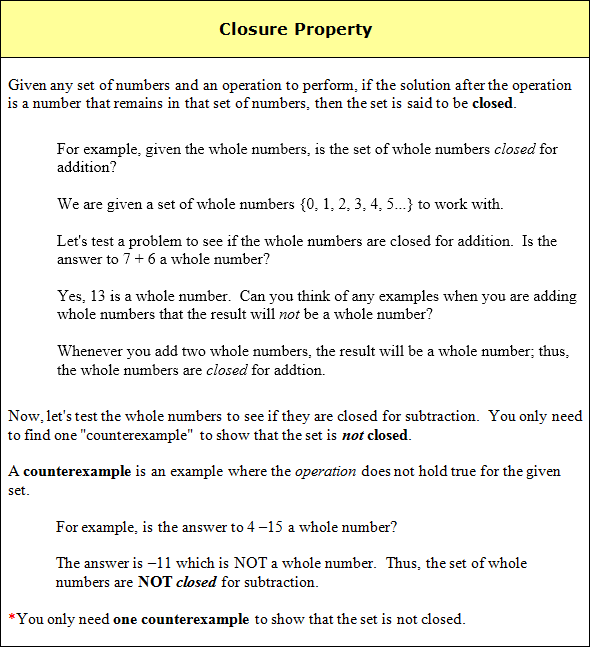 |
Study the figures below to review the closure property.
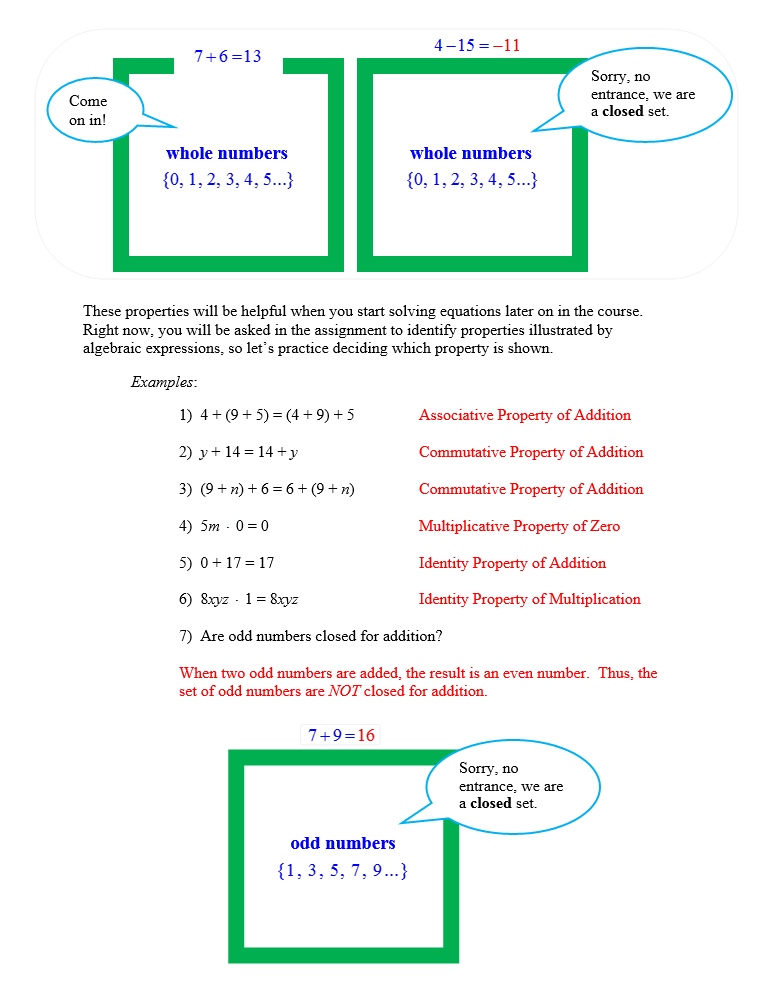 |
Stop! Go to Questions #21-28 to complete this unit.
